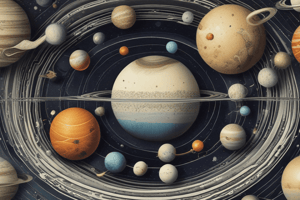Podcast
Questions and Answers
Which of the following celestial bodies have numerous moons?
Which of the following celestial bodies have numerous moons?
- Comets from the Kuiper Belt and Oort Cloud
- Outer planets (Jupiter, Saturn, Uranus, Neptune) (correct)
- Asteroids in the asteroid belt
- Inner planets (Mercury, Venus, Earth, Mars)
What are the two main categories of asteroids mentioned in the text?
What are the two main categories of asteroids mentioned in the text?
- Outer and inner
- Large and small
- Rocky and icy
- Metallic and silicates (correct)
Where do comets originate from, according to the text?
Where do comets originate from, according to the text?
- The inner planets
- The asteroid belt
- The interplanetary medium
- The Kuiper Belt and Oort Cloud (correct)
What is the characteristic feature of comets mentioned in the text?
What is the characteristic feature of comets mentioned in the text?
What does the interplanetary medium refer to, according to the text?
What does the interplanetary medium refer to, according to the text?
Study Notes
The Solar System: A Cosmic Arrangement of Stars and Planets
The solar system, defined as the assembly of celestial bodies that are under the gravitational influence of the Sun, contains a diverse variety of astronomical objects. These range from the central star itself, planets, dwarf planets, moons, asteroids, comets, and meteoroids. Let's delve deeper into each type of object in the solar system:
Central Star: The Sun
At the heart of the solar system is the Sun, an average-sized star in the Milky Way Galaxy. It is the largest body and contains more than 99% of the total mass of the entire system. The Sun emits a constant flow of energy known as the solar wind, which permeates the entire solar system.
Planets
There are eight planets in the solar system, arranged in order from closest to the Sun to furthest: Mercury, Venus, Earth, Mars, Jupiter, Saturn, Uranus, and Neptune. Mercury and Venus are considered terrestrial or rocky planets, while the remaining six are referred to as gas giants. Earth is unique among the planets not only for being the birthplace of life but also for having a single moon.
Dwarf Planets
Pluto, once considered the ninth planet, is now recognized as a dwarf planet along with three others. Dwarf planets share similarities with full planets, such as orbits around other celestial bodies, but do not possess sufficiently clear dominant spherical shapes apparent to the unaided eye.
Moons
More than 150 moons orbit planets and other celestial bodies in the solar system. Notably, the outermost planets have numerous moons, while the inner four are moonless.
Asteroids and Meteroids
Tens of thousands of asteroids are concentrated in the belt between the orbits of Mars and Jupiter. These bodies are remnants of the solar system's formation and are categorized as either metallic, composed primarily of iron or steel, or silicates, made of silicon compounds. Meteoroids are smaller fragments of space debris that occasionally enter Earth's atmosphere and burn up, creating shooting stars.
Comets
Comets are composed of ice and rock that originate from the Kuiper Belt and the Oort Cloud, located beyond Neptune and at the boundary of the Sun's influence, respectively. They exhibit characteristic tails due to their interaction with the solar wind.
Interplanetary Medium
The interplanetary medium refers to the vacuum-like environment that exists throughout the solar system, containing only faint cosmic ray background. It is punctuated by occasional interactions with comets, asteroids, and charged particles released by the Sun.
Studying That Suits You
Use AI to generate personalized quizzes and flashcards to suit your learning preferences.
Description
Test your knowledge on the diverse range of astronomical objects in the solar system, from the central star, planets, dwarf planets, moons, asteroids, comets, to the interplanetary medium. Explore fascinating facts about the Sun, planets like Earth and Jupiter, dwarf planet Pluto, asteroid belts, and more.




